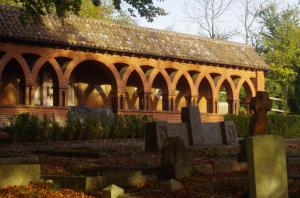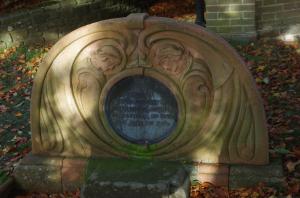
copyright Carole Tyrrell
The golden autumn sunshine of the last afternoon had created long shadows and bathed the leaves on the trees in gold. It was one of those autumn days on which you’re glad to be outdoors to make the most of the last golden days before the dark season sets in. Once you’ve gorged yourself on the beautiful Watts Chapel, make sure that you have left yourself enough time to explore the churchyard. This is a tranquil place which was created by Mary Watts and Compton Parish Council and has gorgeous views over the surrounding countryside from the cloister at the top of the hill. From the road outside we could see the cloister and several of the terracotta memorials, two of which are Grade II listed. The Wattses erected the picturesque oak lych gate at the entrance in 1897. Mary Watts’ terracotta wellhead, encircled by a yew hedge, is along the left hand path. This was designed in 1906 and also Grade II listed. There are inscriptions on its top sides; ‘ the lord god planted a garden eastward in eden and a river went out of eden to water the garden.’
Mary Watts and the Parish Council laid out the cemetery which is also known as the Watts cemetery, in 1895-8. It’s Grade II listed and was created as the old Compton churchyard was completely full. At an 1894 meeting of the Parish Council it was proposed to buy land from the nearby Loseley estate and the Council agreed to raise a sum of £1300 from the poor rate of the parish for the purpose of ‘providing and laying out a Burial ground and building the necessary Chapel or Chapels thereon.’ Mary Watts wrote to the Council a year later, offering to build a cemetery chapel, with her husband’s financial help and inspiration. Evergreens were planted which included cedars and yews and Mary planted the Irish yews. The graveyard and chapel were consecrated by the Bishop of Winchester on 1 July 1898. It was extended in 1950 and a garden of remembrance was added in 1959. The Parish Council still own and manage the cemetery.
The graveyard feels like a much older cemetery and a real part of the community. It was created from local materials and local people with Mary Watts as part of the Compton Potters Guild. As with the Watts Chapel it’s in the Arts and Crafts style that was popular at the time. Mary was fully involved with the churchyard as, from September 1896, she sat on the Parish Council sub-committee that was responsible for the graveyard together with the rector of St Nicholas, H H Gillett, the Loseley landowner William More-Molyneux and Mr Andrews, estate steward at Limnerslease, the Wattses nearby home. It was landscaped in the Romantic style with winding paths and the choice of trees was designed to inspire feelings of mourning and contemplation.

copyright Carole Tyrrell
The cloister was added in 1907. It keeps to a similar Italianate theme as the Chapel. Again, it’s also Grade II listed and has been compared to the loggia in Postmens Park. This was G F Watts, Mary’s husband, memorial to self-sacrifice near St Paul’s in the City of London. There is a memorial to G F Watts on the cloister wall with a small recumbent statue of ‘Signor’ as Mary called him flanked by two seated cherubs. Mary’s memorial tablet is also there.
We didn’t have enough time to find the two Grade II listed memorials; one to Margery Gillett, the Rector’s wife and the other to a novelist, Julian Russell Sturgis(1848 – 1904). We also didn’t find the Huxley family grave either as the author of 1932’s Brave New World, Aldous Huxley’s, ashes are interred with his parents. We did find some m

copyright Carole Tyrrell
The churchyard is still open for burials and we did find one recent terracotta memorial dating from 2012.

copyright Carole Tyrrell
The Chapel and churchyard are the result of one woman’s vision and determination to create a lasting memorial to her husband and to give something lasting to the community. I was full of admiration for Mary Seton Watts as she has left a lasting tribute to Signor and to herself. A significant artist in her right, she was obviously extremely capable, talented and a born organiser. Thanks to her and to Signor, there is a unique place in the Surrey hills for which she will always be remembered.
© text and photos Carole Tyrrell unless otherwise stated
References:
Watts Chapel; An Arts & Crafts Memorial, Veronica Gould & Joanna Howse, Books for Dillons, published 2 October 1993 (NB: This may be out of print but the Gallery may still have a few copies)
https://en.wikipedia.org/wiki/Watts_Cemetery_Chapel
https://historicengland.org.uk/listing/the-list/list-entry/1417498










































